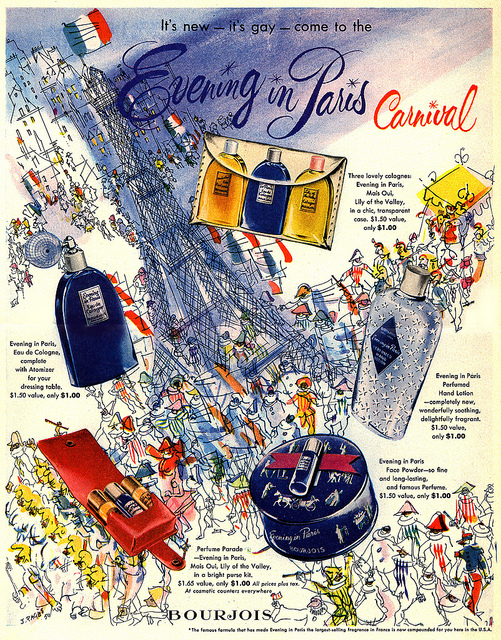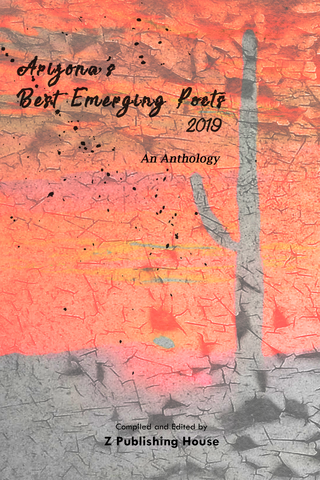Charmed Chaos
Musings on Life, Love, and Linguine-Poetry & Writing
Evening in Paris

My grandmother’s bedroom was my favorite room in her house. She was without a doubt the most famous person I’ve ever known. She was once a blues singer in Vaudeville, a graceful swan now retired to the country. She had an old-fashioned vanity dresser with a huge mirror. There were all sorts of hair brushes, makeup, and hair pins. A huge tin of various buttons and snaps that I loved looking through. But the thing I remember with a vivid clarity were the cobalt blue teardrop bottles. Evening in Paris, her favorite scent.
In 1964 she died, and my dad decided to live in her house. There were very few times my mom let me visit him. He was a reckless soul and knew nothing about children. And as such, he had no idea how I would feel when he stated I was to sleep in grandmother’s bed, the very same bed where she died. I walked into her bedroom, and nothing had changed. The Evening in Paris bottles were still on her dresser, along with all her personal things. I sat down at the dresser, closed my eyes and I could feel her around me.
in her bed, the scent
cotton candy sweet Spring dance-
where her head once lay
©2018 Linda Lee Lyberg












Touching story, Linda! The scent of memories. ❤
LikeLiked by 1 person
Thank you! Yes, scents are so powerful.
LikeLiked by 1 person
What a place… my grandparents rooms was always filled with treasures… used to love them.
LikeLiked by 1 person
Yes, Mine kept everything. But I only have a few treasures from then. Thanks Bjorn.
LikeLike
Beautiful. Thanks for taking us on this visit down the memory lane.
LikeLiked by 1 person
My pleasure! Thank you for visiting.
LikeLiked by 1 person
It has been such a pleasure visiting your site and reading your wonderful posts.
LikeLiked by 1 person
Thank you, truly.
LikeLike
I like how you described the power of her remembrance in that bedroom.
LikeLiked by 1 person
Thank you Frank. I think my Haiku is more of a senryu though.
LikeLiked by 1 person
Whether haiku or senryu, both your prose and poetry evoke strong emotions through the senses.
LikeLiked by 1 person
Thank you so much. I appreciate your kind words.
LikeLiked by 1 person
Finishing up reading the haibuns this morning and so enjoyed finding yours. The prose is rich in detail and you acquaint us with your grandmother as well. It seems to me that in your mind, your grandmother is identified with the “personality” of this room. Details like the vanity and large mirror in the broader strokes…and then delving deeper into the hairbrushes, pins, and the tin of buttons and snaps. I could really be there with you, especially with your choice of the word “tin” rather than box. And oh my….I have not thought of Evening in Paris and its trademark cobalt blue teardrop container in years! My grandmother also had a bottle on her dresser. The added details about your family dynamics enrich the prose. I love that you think of her as a swan. Thank you so much for sharing!
The micropoem at the end is just perfect for the prose. It brings your memory to life….that sweet scent. You mention the sweet scent of Spring…so the reference to a season is there. For it to be a traditional haiku, it would need to be about nature and be based in nature. These three lines are about the room, the bed, the lovely scent on the pillow, the memories it brings. And that’s why I say this is alovely micro poem. If you wanted to change it (but I love this write the way it is) to a traditional haiku, perhaps you could write about a swan….perhaps she is nestling signets (I think that’s what you call baby swans)…perhaps there are lily blooms about which would be the kigo about spring…or you could mention spring itself….perhas the “break” could be scents of spring wafting up beside a pond….or shift in the last line to a person walking by and smiling….The main thing is to base it in nature itself. Hope this helps to understand the difference here. I’m still working hard to understand the delicate balances in three lines that form a traditional Japanese haiku. Perhaps reading some of the other posts will help as well. But for this write….I do love it just the way it is!
LikeLiked by 1 person
Lillian- thank you for your in-depth comments. I appreciate the feedback, truly! I will leave it as is, I do think it conveys my emotions regarding my grandmother. I will keep in mind your points on Haiku. Again, humble thanks!
LikeLiked by 2 people
I love it as is❤️
LikeLiked by 2 people
Beautiful story Linda
LikeLiked by 2 people
Thank you Andrew. I’m happy you enjoyed it.
LikeLiked by 1 person
I love the story about your grandmother, and adore the poem you wrote. You know me well enough to know that “traditional forms” are fine for “traditional poets”, but I am anything but a traditional poet. I do, however, respect them and the beauty if their poetry. I just like to color outside the lines. ❤☺
LikeLiked by 1 person
Thanks so much Walt! I am a rebel too, at times. 😉
LikeLiked by 1 person
You’re very welcome Linda! ☺❤
LikeLiked by 1 person
❤️😊
LikeLiked by 1 person
Beautifully done. I used to sleep in my gran’s bed when I visited her – she took herself off to the guest room (bizarre). I cannot imagine sleeping in that bed once she was no longer with us, but it is good to know you felt her presence with love and not fear.
LikeLiked by 1 person
Thank you for sharing your life very thought.
LikeLike
What an interesting story! It must have been quite emotional to sleep in your grandma’s bed.
LikeLiked by 1 person
Yes, it certainly was.
LikeLiked by 1 person
Reblogged this on The Reluctant Poet.
LikeLike